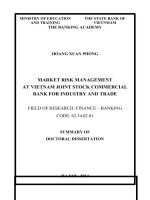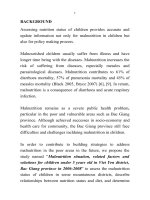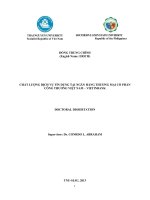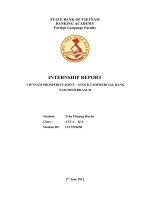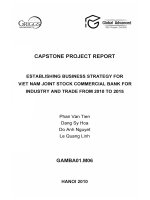54 SOME SOLUTIONS TO REDUCE CREDIT RISKS AT VIET NAM PROSPERITY JOINT STOCK COMMERCIAL BANK
Bạn đang xem bản rút gọn của tài liệu. Xem và tải ngay bản đầy đủ của tài liệu tại đây (320.85 KB, 68 trang )
MINISTRY OF FINANCE
ACADEMY OF FINANCE
--------------------
Student:
Group:
Nguyễn Thành Quang
CQ53/51.02
GRADUATION THESIS
TOPIC:
SOME SOLUTIONS TO REDUCE CREDIT RISKS AT VIET NAM
PROSPERITY JOINT STOCK COMMERCIAL BANK
Major :
English for Finance and Accounting
Student code: 155D2202010060
Supervisor:
Ms Pham Phuong Oanh
[Hanoi-2019]
Graduation thesis
Academy of Finance
DECLERATION
Thereby declare that this graduation thesis is based on my work except for
quotations and citations that have been duly acknowledged. I also declare that it has
not been previously or simultaneously submitted at Academy Of Finance or other
institutions.
Graduation thesis author
Nguyen Thanh Quang
Nguyen Thanh Quang
CQ53/51.02
Graduation thesis
Academy of Finance
ABSTRACT
This research involves identifying the credit performance of Viet Nam Prosperity Joint
Stock Commercial Bank between 2015 and 2017. The goal is to show that the firm
could improve its income results through both of internal and external sources. This
has been done by analyzing financial and credit risk ratios throughout the years, which
includes debt ratios and capital turnover ratios. Upon the analysis on these factors, it
becomes clear that VP Bank was getting better with the decrease in the loss of
outcome to achieve the target corporate goal in the long run. Through showing the
financial wealth of VP Bank, this research highlights the importance of running the
business with careful strategies in order to survive in the modern economy.
Nguyen Thanh Quang
CQ53/51.02
Graduation thesis
Academy of Finance
ACKNOWLEDGEMENT
No thesis can be completed without a great deal of help and encouragement. I
am exceedingly grateful to all people for giving me such huge supports.
Firstly, I would like to give my heartfelt thanks to my instructor, Ms. Pham
Phuong Oanh at Academy of Finance for her enthusiastic supervision from the
beginning of forming thesis’s topic until the completion. Despite of busy time
schedule, she still spent a lot of time listening to my opinions whenever necessary,
contributing her comments and ideas, and correcting thesis draft.
Secondly, I express profound gratitude to my thesis guide, Mr. Bui Thanh Hai –
a credit officer of VP Bank. He helped me to collect all essential data, explained me
what I am confused, provided me useful advice to comprehend problems in the thesis.
I also wish to send my heartfelt thanks to all staffs of the VP Bank, who created a
welcomes condition for me during the time I was taking field study there.
For the valuable knowledge and studying encouragement, my sincere thanks go
to all my teachers in the Faculty of Foreign Language – Academy Of Finance, who
have provided me with worthy lessons throughout 4 years of study.
Lastly, from the bottom of my heart, I want to dedicate this report to my parents,
who created all the greatest opportunities for me to fulfill my studies and desire. They
are always support me unconditionally. Everything I do, I know I have them beside
me and that thought is the motivation for me to overcome all the difficulties and stress
during not only this internship but also my whole life.
Sincerely thanks again for all of your support and inspiration!
Nguyen Thanh Quang
CQ53/51.02
Graduation thesis
Academy of Finance
LIST OF ABBREVIATION
VP Bank
Vietnam Prosperity Joint Stock Commercial Bank
C&I
Commercial and industrial
DSCR
Debt service coverage ratio
REITs
Real estate investment trusts
PSE
Professional sales employee
UPL
Unsecured personal loan
SME
Small and medium enterprise
NFS
Non - financial service
CMB
Commercial banking division
FDI
Foreign direct investment
IFC
International finance corporation
ICBS
Industrial and commercial bank of China
Nguyen Thanh Quang
CQ53/51.02
Graduation thesis
Academy of Finance
LIST OF FIGURES AND TABLES
Table 2.1: Analysis of total asset structure of VP Bank in period 2015-2017
Table 2.2: Analysis of liabilities structure of VP Bank in period 2015-2017
Table 2.3: Analysis of total operating income of VP Bank in period of 2015-2017
Nguyen Thanh Quang
CQ53/51.02
Graduation thesis
Academy of Finance
TABLE OF CONTENTS
DECLARATION
ABSTRACT
ACKNOWLEDGEMENT
LIST OF ABBREVIATION
LIST OF FIGURES AND TABLES
TABLE OF CONTENTS
INTRODUCTION
1.
Rationale of the study
2.
Aims to the study
3.
Methodology
4.
Scope of the study
5.
Organization of the study
CHAPTER 1: LITERATURE REVIEW
1.1. OVERVIEW OF CREDIT AND BANK CREDIT
1.1.1. The basic definition of credit and bank credit
1.1.2. Role of bank credit
1.1.3. Classification of bank credit
1.2. CONTENTS OF BANK CREDIT RISKS
1.2.1. The basis definiton of risks
1.2.2. Concept of bank credit risks
1.2.3. Some indicators of credit activity evaluation
1.3.CAUSES OF BANK CREDIT RISKS
1.3.1. From the Bank
1.3.2. From customer
Nguyen Thanh Quang
CQ53/51.02
Graduation thesis
Academy of Finance
1.4: THE IMPACTS OF BANK CREDIT RISKS……………………………..15
1.4.1: For customer ……………………………………………………………15
1.4.2: For the Bank ………………………………………………………………………16
CHAPTER 2: THE STUDY
2.1 GENERAL INFORMATION ABOUT VIETNAM PROSPERITY JOINT STOCK
COMMERCIAL BANK
2.1.1 Brief intriduction about the company
2.1.2 The formation and development process
2.1.3. Organizational structure of the Bank
2.2 THE PRACTICAL SITUATION OF CREDIT AND CREDIT RISKS AT VP BANK
2.2.1 Area of banking operations .
2.2.2 Business performance results
2.2.3 The situation of credit activity
2.2.4 Risk management system at VP Bank – Kim Lien Branch
2.3 THE GENERAL ASSESSMENT CREDIT ACTIVITY AT VIET NAM PROSPERITY
JOINT STOCK COMMERCIAL BANK
CHAPTER 3: SOME SOLUTIONS TO IMPROVE CREDIT PERFORMANCE AT VP
BANK
3.1 THE DEVELOPMENT ORIENTATION OF VP BANK ………………….
3.1.1 Social - economic context
3.1.2 Aim and operating orientation of VP Bank
3.2 SOME SOLUTIONS .......TO IMPROVE CREDIT PERFORMANCE AT VP BANK
3.2.1 Promoting the capital mobilization
3.2.2 Marketing and customer service improvement
3.2.3 Diversifying credit products
3.2.4: Improving professional qualifications of credit officers ………………..53
3.2.5: Loan monitoring promotion …………………………………………….54
3.2.6: Participating in credit insurance…………………………………………54
Nguyen Thanh Quang
CQ53/51.02
Graduation thesis
Academy of Finance
3.3 RECOMMENDATIONS
CONCLUSION
REFERENCES
Nguyen Thanh Quang
CQ53/51.02
Graduation thesis
Academy of Finance
INTRODUCTION
1. Rationale of the study
International economic integration is an inevitable trend of mankind,
taking place strongly not only in the region but also around the world.
With this trend in mind, Vietnam has also made strong steps to bring a lot
of development opportunities for its economic sectors. Through many
difficulties and challenges, our economy has achieved encouraging
achievements. To achieve that, there is a significant contribution of the
banking industry as an "economic lever" through credit activities.
Bank credit is a tool to finance capital for the economy, contributing to the
promotion of the balanced development of other industries and sectors
according to the State's orientation. Credit activity is the main business of
the Vietnamese commercial banking system, bringing about 80-90% of
each bank's income, but its risks are not small. Excessive high credit risk
will greatly affect the banking business. Facing the opportunities and
challenges of the process of international economic integration, the issue
of improving the competitiveness of commercial banks, particularly
improving credit quality and minimizing risks, has become necessary.
Actually, there are many internal and external reasons causing credit risks
situation for the Bank in Viet Nam. The lack of management skill, for
example, can limit the profitability and competiveness of the Bank. As a
result, many theories as well as some solutions related to credit activity
issues are carried out.
Starting from the urgency of the problem, I decide to carry out research
Nguyen Thanh Quang
1
CQ53/51.02
Graduation thesis
Academy of Finance
about credit activity. My graduation thesis titled: “Solutions to credit risks
at Viet Nam Prosperity Commercial Joint Stock Bank” is carried out.
2. Aim of the study
The aims of the study are to research about credit activities and credit
risks situation of the Bank in order to suggest some solutions to credit
risks prevention of the Bank.
3. Scope of the study
Because of the limited time and scale, this research only focuses on the
credit activities and credit risk situation of Viet Nam Prosperity
Commercial Joint Stock Bank over period of three years from 2015 to
2017.
4. Methods of the study
Method of gathering documents and data is mainly base on bank’s
internal
documents, specially from financial report. Data collected were used to
analytic credit activity and credit risks situation in Viet Nam Prosperity
Joint Stock Commercial Bank. From that analytic, we suggest the best
solutions to the credit risks reduction.This data were been collected from
financial report and the reports of credit operations in 3 years 2015 and
2017.The selected method in the thesis to write this study is statistics,
analyzing and summarizing to analyze the bank’s credit acticity. Lastly, I
also use knowledge I have acquired during the time I study in Academy of
Finance to do this research.
5. Organization of the study
Nguyen Thanh Quang
2
CQ53/51.02
Graduation thesis
Academy of Finance
My graduation thesis is divided into three main parts:
Chapter 1: The study - Overview of credit and bank credit
Chapter 2: Situation of credit activity and credit risks at Viet Nam
Prosperity
Joint Stock Commercial Bank which shows more details about the credit
activity, the
situation of credit risk and general assessment of credit
activity
at VP Bank.
Chapter 3: Some solutions to credit risk reduction at Viet Nam Prosperity
Joint Stock Commercial Bank which shows the suitable solutions basing on
orientation of the Bank.
Nguyen Thanh Quang
3
CQ53/51.02
Graduation thesis
Academy of Finance
CHAPTER 1: LITERATURE REVIEW
1.1: OVERVIEW OF CREDIT AND BANK CREDIT
1.1.1: The basic definition of credit and bank credit
Credit is an economic category, it is born, exists and grows with the development
of a commodity economy. In a narrow sense, credit is borrowed, in which two
subjects are borrowers and lenders will agree on an interest rate and a certain
debt term. In a broad sense, credit is the mobilization of the surplus capital. Thus,
the concept of credit can be given as follows: credit is a borrowing relationship
based on the principle of repayment (both capital and interest) after a certain
period of time.
Bank credit is a credit relationship between a bank and credit institutions with
economic sectors such as businesses, organizations, individuals, households ... in
which the bank act as intermediaries to mobilize capital for the above objects and
use the mobilized capital to lend. So in the above relationship, the Bank is both a
borrower and a lender.
( Source: )
As a borrower, the Bank receives deposits or issues certificates of deposit, bonds,
etc. to focus on temporary idle capital sources in society as the source of its
Nguyen Thanh Quang
4
CQ53/51.02
Graduation thesis
Academy of Finance
operating
capital.
As a lender, the Bank provides credit to all economic sectors in various forms
such as lending, discounting valuable papers, guaranteeing and financial leasing
through activities. This bank can provide timely capital to the economy while
maximizing the efficiency of its capital use.In other word, bank credit is the
aggregate amount of credit available to a person or business from a banking
institution. It is the total amount of funds financial institutions provide to an
individual or business. A business or individual's bank credit depends on the
borrower's ability to repay and the total amount of credit available in the banking
institution.
1.1.2: Roles of bank credit
There are some important roles of bank credit.
The first is its contribution to promoting production and circulation of
goods.Bank credit helps businesses shorten the time to accumulate capital,
quickly invest to expand production, and contribute to speeding up the capital
concentration and capital accumulation for the economy. In the present
conditions, along with the deepening of international distribution and
cooperation, the mobilization process is not limited to the national level and it
also forms relationships around the world.
Another role of bank credit is contributing to stabilizing currencies and prices.
Credit has reduced the amount of cash left in circulation by taking advantage of
idle capital in society. Therefore, bank credit is considered one of the effective
measures contributing to reducing inflation and stabilizing the currency. On the
other hand, by providing credit to the economy, supporting enterprises to
complete their production and business plans, making production more and
Nguyen Thanh Quang
5
CQ53/51.02
Graduation thesis
Academy of Finance
more developed that meet the demand of society. Bank credit alsocontributes to
stabilizing the domestic price market. Thus, bank credit has contributed
significantly to stabilizing the currency, facilitating price stability, which is an
important prerequisite for production and circulation development.
Lastly, bank credit also brings developing economic relationships with foreign
countries. Under current conditions, the economic development of a country is
always associated with the world market, bank credit has become one of the
measures to connect economic relations between countries. For developing
countries and our country in particular, credit plays a very important role in
expanding the export of goods and at the same time thanks to external credit to
industrialize and modernize the economy.
1.1.3: Classification of bank credit
1.1.3.1: In term of the using purpose
Bank credit can be divided into the following groups
Loans for industrial and commercial production
A commercial and industrial (C&I) loan is a type of loan made to a business or
corporation as opposed to an individual. Commercial and industrial loans can be
made in order either to provide either working capital or finance capital
expenditures like machinery or a piece of equipment. This type of loan is usually
short-term in nature and is almost always backed by some sort of collateral.
Commercial loans usually charge flexible rates of interest that are tied to the
bank prime rate. Many borrowers must also file regular financial statements, at
least annually or more frequently in the case of borrowers that carry higher risk.
Nguyen Thanh Quang
6
CQ53/51.02
Graduation thesis
Academy of Finance
Lenders usually require proper maintenance of the loan collateral property and
hold borrowers to certain covenants such a debt service coverage ratio (DSCR).
Small and medium-sized businesses make up the bulk of borrowers for C&I loans
because they generally cannot generate sufficient cash flow to continuously selffund operations and because they lack the access to the equity and bond markets
that large companies enjoy.
To further refine the definition of C&I loans, they are distinct from consumer
loans and real estate loans. Banks break out these loan categories in their
financial
statements.
Loans for personal consumer
An amount of money lent to an individual (usually on a nonsecured basis) for
personal, family, or household purposes. Consumer loans are monitored by
government regulatory agencies for their compliance with consumer protection
regulations such as the Truth in Lending Act. Also called consumer credit or
consumer lending. In other words, a consumer loan also known as a personal is a
secured or unsecured loan with fixed terms issued by a bank or financing
company that may be used for any purpose but is typically tied to the purchase of
a specific item. Unsecured loans are issued based on the creditworthiness of the
borrower while secured loans are collateralized by the personal property of the
borrower.
Loans for commercial real estate
A commercial real estate loan is a mortgage loan secured by a lien on commercial,
rather than residential, property. Commercial real estate (CRE) refers to any
income-producing real estate that is used solely for business purposes, such as
retail centers, office complexes, hotels and apartments.
Nguyen Thanh Quang
7
CQ53/51.02
Graduation thesis
Academy of Finance
Typically, an investor (often a business entity) purchases commercial property,
leases out space, and collects rent from the businesses that operate within the
property. Financing, including the acquisition, development and construction of
these properties, is typically accomplished through commercial real estate loans.
Commercial real estate loans are typically made to business entities formed for
the specific purpose of owning commercial real estate. Entity types include
corporations, developers, partnerships, funds, trusts, and real estate investment
trusts or real estate investment trusts (REITs).
Loans for import and export business
Import and export loans use the goods being shipped or proof of the transaction
as the collateral for the loan which provide working capital for your business.
1.1.3.2: In term of the credit term
According to this criteria, bank credit can be divided into the following
categories. The first one is short-term loans which are loans with a term of less
than one year. For example, when your business doesn't qualify for a line of credit
from a bank, you might still have success in obtaining money from then in the
form of a one-time, short-term loan (less than a year) to finance your temporary
working capital needs. Another one is medium-term loans that is loan with a
maturity generally between one year and 10 years. For example, if one borrows
$10,000 to pay for college, and must repay it in seven years, then he/she has
taken out a medium-term loan. The purpose of this type of loan is usually to
finance investment in fixed assets. Lastly, long-term loan is a loan that is to
be paid back over a period of timebetween three and ten years, and sometimes
for as long as twenty years. The purpose of this type of loan is usually to finance
investments in portfolios.
Nguyen Thanh Quang
8
CQ53/51.02
Graduation thesis
Academy of Finance
1.1.3.3: In term of the creditworthiness of customers
Unsecured lending (UL)
An unsecured loan is a loan that is issued and supported only by the borrower's
creditworthiness, rather than by any type of collateral. Because unsecured loans,
sometimes referred to as signature loans or personal loans, are obtained without
the use of property as collateral, the terms of such loans, including approval and
receipt, are most often contingent on the borrower's credit score. Borrowers
must generally have high credit ratings to be approved for certain unsecured
loans.
An unsecured loan stands in direct contrast to a secured loan, in which a
borrower pledges some type of asset as collateral for the loan, in turn increasing
the lender's "security" for providing the loan. Unsecured loans are bigger risks
for lenders, and as a result, they typically have higher interest rates and require
higher credit scores than secured loans such as mortgages or car loans. In some
instances, lenders will allow loan applicants with insufficient credit to provide a
cosigner, who can take on the legal obligation to fulfill a debt should the borrower
default.
Guaranteed loans
A guaranteed loan is a loan that a third party guarantees or assumes the debt
obligation in the event that the borrower defaults. Sometimes, a guaranteed loan
is guaranteed by agovernment agency, which will purchase the debt from the
lending financial institution and take on responsibility for the loan.
A guaranteed loan agreement may be made when a borrower is an unattractive
Nguyen Thanh Quang
9
CQ53/51.02
Graduation thesis
Academy of Finance
candidate for a regular bank loan. It is a way for people who need financial
assistance to secure funds when they otherwise may not qualify to acquire them.
And the guarantee means that the lending institution does not incur excessive
risk in issuing these loans.
1.1.3.4: In term of the lending method
Loan by item or loan each time
Lending by one time is the method of lending, each time borrowing Customers
and banks must apply for necessary loans and sign credit contracts.
Lending by credit limit
Bank and customer determine and agree on a credit limit, maintaining for a
certain period of time. Credit limit is the maximum level of outstanding loans
maintained within a certain period of time agreed by the bank and customer in
the
credit
contract.
1.2: CONTENTS OF BANK CREDIT RISKS
1.2.1: The basic definition of risks
Risk means the possibility of something bad happening at some time in the
future; a situation that could be dangerous or have a bad result. In other word, it
is a person or business that a bank or an insurance company is willing or
unwilling to lend money or sell insurance to because they are likely/unlikely to
pay back the money.
( Source: )
Nguyen Thanh Quang
10
CQ53/51.02
Graduation thesis
Academy of Finance
Risk takes on many forms but is broadly categorized as the chance an outcome or
investment's actual return will differ from the expected outcome or return. Risk
includes the possibility of losing some or all the original investment. Different
versions of risk are usually measured by calculating the standard deviation of the
historical returns or average returns of a specific investment.
1.2.2: Concept of bank credit risk
1.2.2.1: The definition of bank credit risk
Credit risk is the probable risk of loss resulting from a borrower's failure to repay
a loan or meet contractual obligations. Traditionally, it refers to the risk that a
lender may not receive the owed principal and interest, which results in an
interruption of cash flows and increased costs for collection. Although it is
impossible to know exactly who will default on obligations, properly assessing
and managing credit risk can lessen the severity of loss. Interest payments from
the borrower or issuer of a debt obligation are a lender's or investor's reward for
assuming credit risk.
When lenders offer mortgages, credit cards, or other types of loans, there is a risk
that the borrower may not repay the loan. Similarly, if a company offers credit to
its client, there is a risk that its clients may not pay their invoices. Credit risk also
describes the risk that a bond issuer may fail to make payment when requested
or that an insurance company will be unable to pay a claim.
Joel Bessis (1998), Risk management in Banking. Credit risk is understood from
losses due to customers not being able to repay a debt or a decrease in credit
quality
of
loans.
Credit risk is the type of risk that arises when one of the parties to a credit
contract is unable to pay the other parties. For commercial banks, credit risk
Nguyen Thanh Quang
11
CQ53/51.02
Graduation thesis
Academy of Finance
arises in case the bank does not collect both principal and interest of loans, or
payment of principal and interest on time. If all bank loans are paid in full and on
time both principal and interest, the bank is not subject to credit risk. Conversely,
if the borrower is unable to pay the debt or deliberately fails to pay the debt, the
risk arises. Credit risk is not only limited to lending activities but also includes
many other credit activities of commercial banks such as: guarantee activities,
foreign trade financing, financial leasing.
1.2.2.2: Some indicators of credit activity evaluation
Loan outstanding on mobilized capital
This indicator reflects the efficiency of using capital of banks, how much banks
can borrow compared to the mobilized capital. besides, the efficiency of using
bank deposits
Debt
A=
x 100%
Mobilized capital
Targets of debt collection turnover on loan sales
Debt collection revenue
B=
x 100%
Loan revenue
This indicator evaluates the credit efficiency of debt collection by banks. It
reflects in a certain period of time, with how much capital the bank will earn.
The higher the ratio shows, the better the bank's debt collection revenue and the
lower the ratio, the lower the bank's debt collection revenue, which adversely
affects the bank's development.
Target overdue debt on total outstanding loans
Nguyen Thanh Quang
12
CQ53/51.02
Graduation thesis
Academy of Finance
Bad debt
C=
x 100%
Total loans
The most important indicator to assess credit performance is bad debt. The total
bad debt of the bank includes overdue debt, overdue debt and convertible debt to
due debt. For this indicator it may be a relative or absolute index calculated as the
percentage of the total loan balance of the same period of the bank. So. This
indicator shows the actual effectiveness of the bank's credit operations and the
bank's ability to manage credit in the lending process.
If the bank's bad debt figures are low, the bank's operations are effective. In
contrast, credit data is high, the bank's credit activity is still ineffective
Credit capital turnover
Debt collection revenue
D=
( round )
Average debt
The credit capital turnover target of the bank measures the bank's credit rotation
speed, the bank's debt recovery time is fast or slow. The faster the capital
turnover is, the better the investment is. Thus speeding up the credit capital cycle
contributes to reducing risks and increasing credit performance, which brings the
desired profit.
All of these indicators are closely related to each other and serve as a basis for
assessing a bank's credit performance.
Nguyen Thanh Quang
13
CQ53/51.02
Graduation thesis
Academy of Finance
1.2.2.3: Acessing of bank credit risk
Credit risks are estimated based on the borrower's overall ability to repay. To
assess credit risk on a consumer loan, lenders look at the five C's: credit history,
capacity to repay, capital, the loan's conditions and associated collateral.
Some companies have established departments solely responsible for assessing
the credit risks of its current and potential customers. Technology has afforded
businesses the ability to quickly analyze data used to assess a customer's risk
profile.
1.3: CAUSES OF BANK CREDIT RISK
1.3.1: From banks
A bank is a special business that borrows money at low interest rates and then
lends at a higher interest rate to enjoy the interest rate differential. Therefore,
banks always carefully consider before lending to effectively avoid the risk of
losing capital. Therefore, credit risk due to bank causes often accounts for a small
proportion and the main reasons can be listed as below
Firstly, the bank does not have enough information about statistics and targets. to
analyze and evaluate customers leading to ineffective determination of the loan
application, or the determination of the loan term and repayment is not
consistent with the customer's business plan.
Secondly, it may be due to the loose in the process of inspection and supervision
after lending, so it is not timely to detect the phenomenon of using loans for
wrong purposes.The bank is too confident in collateral, guarantee and insurance
as a material to ensure the recovery of principal and loan interest, leading to risks
Nguyen Thanh Quang
14
CQ53/51.02
Graduation thesis
Academy of Finance
in capital recovery process. At present, there is a phenomenon that some banks
run by quantity (according to plan) but neglect to respect the quality of the loan,
too optimistic, believe in the success of the business plan to control the the
amount of credit reduced effectively.
The last reason causes from the lack of the ethical and professional qualification
of the staff. Bank may lack a specialized department to monitor, manage risks,
manage the maximum credit limit for each customer in each industry jobs and
products of different localities to disperse risks and necessary forecasts in each
period. Credit officers do not follow the loan process properly or because the
credit process is lacking and inappropriate. Banks violate the principles in
lending, lending beyond safety ratios, or lack of collateral and pledge. Due to the
low quality of credit officers, it is necessary to appraise customers to lend
incorrectly or credit officers violating ethics in lending, colluding with customers
to lend to banks in contravention of regulations or Credit officers takes up loans,
leading to overdue debts and increasing bad debts.
1.3.2: From customers
Risks from customers are the main reason leading to risks in credit operations of
banks. It is very difficult and complicated that prevent credit risk from customers
Risks occur often by the following reasons
Firstly, it is the lack of financial capacity. Borrowers do not have enough financial
capacity to pay debts, leading to difficulties in recovering debts of the Bank.
Specifically, the financial reasons here include many factors, which may be due to
non-compliance with the original plan, unreasonable financial planning, incurred
unforeseen expense items. When customers borrow money to expand their
business scale, most of them concentrate on investing in material assets, but few
customers
dare to boldly innovate to provide management and investment for the
apparatus. monitor business, finance, accounting in accordance with standards.
Nguyen Thanh Quang
15
CQ53/51.02
Graduation thesis
Academy of Finance
The business size that is too big for the management mindset is the cause of the
bankruptcy of viable business plans that should have been successful in reality.
Accordingly, weak business management ability causes business losses of
enterprises, seriously affecting customers' ability to repay debts, increasing the
proportion of overdue debts and bad debts in banks.
Secondly, the lack of customer’s legal capacity also causes credit risk. When
customers lack legal capacity, the bank's debt recovery is also difficult due to
procedural and time constraints.
Thirdly, using capital for wrong purposes is one of the main reasons for the
bank's credit risk. It is the fact that customers use their loans not according to the
agreed purpose in the credit contract. This leads to customers losing money and
being unable to repay the bank
1.3.2.2: From enterprise
Because in the course of business activities, enterprises have their business
licenses revoked, which leads to production and business failure and are unable
to
repay
the
bank.
Professional capacity and leadership prestige of enterprises are reduced, moral
profession is weak, lack of interest to well implement the stages of the
organization, business management or trade restrictions. Professional career of
business employees leads to weak business and loss.
The change in state policy also affects the production and business activities of
enterprises, thereby affecting the bank's ability to recover debts.
1.4: THE IMPACTS OF BANK CREDIT RISK
1.4.1: For customers
Nguyen Thanh Quang
16
CQ53/51.02


